女性主义翻译的影响(英文)
- 格式:doc
- 大小:57.00 KB
- 文档页数:5
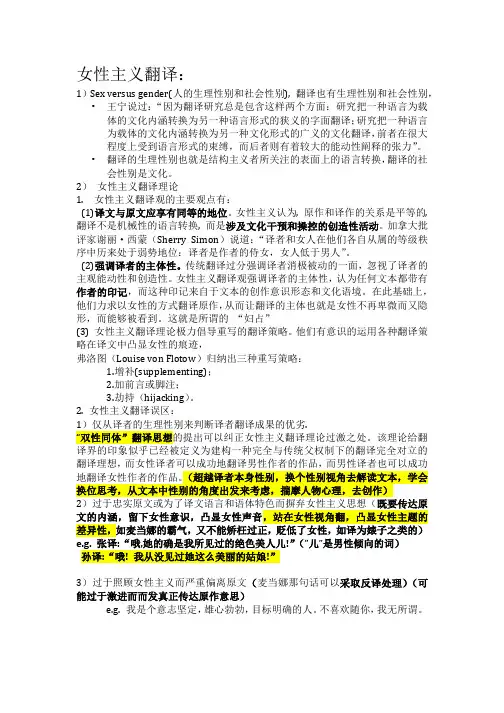
女性主义翻译:1)Sex versus gender(人的生理性别和社会性别), 翻译也有生理性别和社会性别,•王宁说过:“因为翻译研究总是包含这样两个方面:研究把一种语言为载体的文化内涵转换为另一种语言形式的狭义的字面翻译;研究把一种语言为载体的文化内涵转换为另一种文化形式的广义的文化翻译,前者在很大程度上受到语言形式的束缚,而后者则有着较大的能动性阐释的张力”。
•翻译的生理性别也就是结构主义者所关注的表面上的语言转换,翻译的社会性别是文化。
2)女性主义翻译理论1. 女性主义翻译观的主要观点有:(1)译文与原文应享有同等的地位。
女性主义认为, 原作和译作的关系是平等的, 翻译不是机械性的语言转换, 而是涉及文化干预和操控的创造性活动。
加拿大批评家谢丽·西蒙(Sherry Simon)说道:“译者和女人在他们各自从属的等级秩序中历来处于弱势地位:译者是作者的侍女,女人低于男人”。
(2)强调译者的主体性。
传统翻译过分强调译者消极被动的一面,忽视了译者的主观能动性和创造性。
女性主义翻译观强调译者的主体性,认为任何文本都带有作者的印记,而这种印记来自于文本的创作意识形态和文化语境。
在此基础上,他们力求以女性的方式翻译原作,从而让翻译的主体也就是女性不再卑微而又隐形,而能够被看到。
这就是所谓的“妇占”(3) 女性主义翻译理论极力倡导重写的翻译策略。
他们有意识的运用各种翻译策略在译文中凸显女性的痕迹,弗洛图(Louise von Flotow)归纳出三种重写策略:1.增补(supplementing);2.加前言或脚注;3.劫持(hijacking)。
2. 女性主义翻译误区:1)仅从译者的生理性别来判断译者翻译成果的优劣.“双性同体”翻译思想的提出可以纠正女性主义翻译理论过激之处。
该理论给翻译界的印象似乎已经被定义为建构一种完全与传统父权制下的翻译完全对立的翻译理想,而女性译者可以成功地翻译男性作者的作品,而男性译者也可以成功地翻译女性作者的作品。
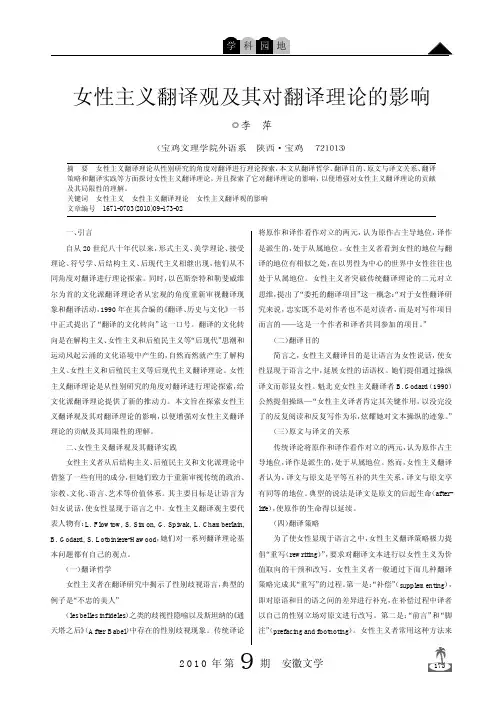

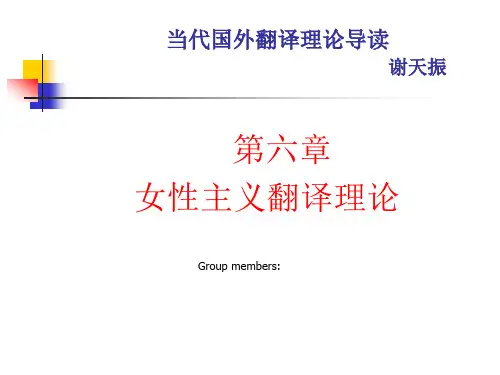
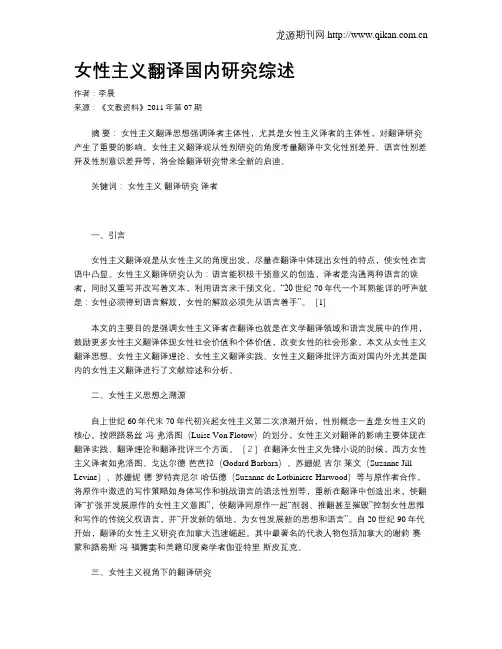
女性主义翻译国内研究综述作者:李晨来源:《文教资料》2011年第07期摘要:女性主义翻译思想强调译者主体性,尤其是女性主义译者的主体性,对翻译研究产生了重要的影响。
女性主义翻译观从性别研究的角度考量翻译中文化性别差异、语言性别差异及性别意识差异等,将会给翻译研究带来全新的启迪。
关键词:女性主义翻译研究译者一、引言女性主义翻译观是从女性主义的角度出发,尽量在翻译中体现出女性的特点,使女性在言语中凸显。
女性主义翻译研究认为:语言能积极干预意义的创造,译者是沟通两种语言的读者,同时又重写并改写着文本,利用语言来干预文化。
“20世纪70年代一个耳熟能详的呼声就是:女性必须得到语言解放,女性的解放必须先从语言着手”。
[1]本文的主要目的是强调女性主义译者在翻译也就是在文学翻译领域和语言发展中的作用,鼓励更多女性主义翻译体现女性社会价值和个体价值,改变女性的社会形象。
本文从女性主义翻译思想、女性主义翻译理论、女性主义翻译实践、女性主义翻译批评方面对国内外尤其是国内的女性主义翻译进行了文献综述和分析。
二、女性主义思想之溯源自上世纪60年代末70年代初兴起女性主义第二次浪潮开始,性别概念一直是女性主义的核心。
按照路易丝·冯·弗洛图(Luise Von Flotow)的划分,女性主义对翻译的影响主要体现在翻译实践、翻译理论和翻译批评三个方面。
[2]在翻译女性主义先锋小说的时候,西方女性主义译者如弗洛图、戈达尔德·芭芭拉(Godard Barbara)、苏姗妮·吉尔·莱文(Suzanne Jill Levine)、苏姗妮·德·罗特宾尼尔·哈伍德(Suzanne de Lotbiniere-Harwood)等与原作者合作,将原作中激进的写作策略如身体写作和挑战语言的语法性别等,重新在翻译中创造出来,使翻译“扩张并发展原作的女性主义意图”,使翻译同原作一起“削弱、推翻甚至摧毁”控制女性思维和写作的传统父权语言,并“开发新的领地,为女性发展新的思想和语言”。
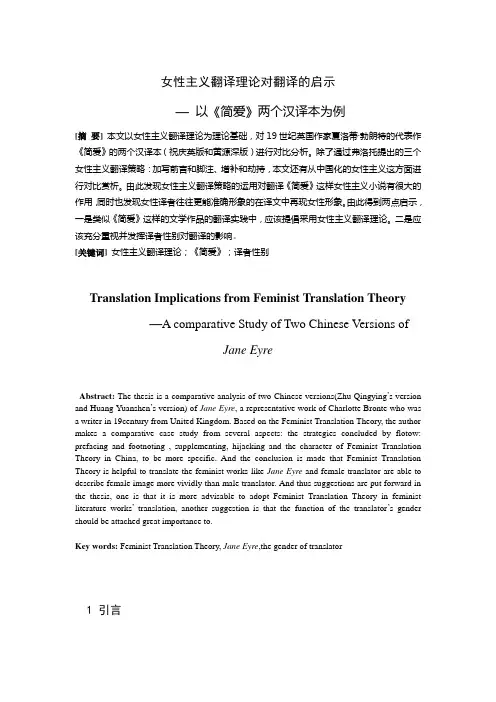
女性主义翻译理论对翻译的启示—以《简爱》两个汉译本为例[摘要] 本文以女性主义翻译理论为理论基础,对19世纪英国作家夏洛蒂〃勃朗特的代表作《简爱》的两个汉译本(祝庆英版和黄源深版)进行对比分析。
除了通过弗洛托提出的三个女性主义翻译策略:加写前言和脚注、增补和劫持,本文还有从中国化的女性主义这方面进行对比赏析。
由此发现女性主义翻译策略的运用对翻译《简爱》这样女性主义小说有很大的作用,同时也发现女性译者往往更能准确形象的在译文中再现女性形象。
由此得到两点启示,一是类似《简爱》这样的文学作品的翻译实践中,应该提倡采用女性主义翻译理论。
二是应该充分重视并发挥译者性别对翻译的影响。
[关键词] 女性主义翻译理论;《简爱》;译者性别Translation Implications from Feminist Translation Theory—A comparative Study of Two Chinese Versions ofJane EyreAbstract: The thesis is a comparative analysis of two Chinese versions(Zhu Qingying’s version and Huang Yuanshen’s version) of Jane Eyre, a representative work of Charlotte Bronte who was a writer in 19century from United Kingdom. Based on the Feminist Translation Theory, the author makes a comparative case study from several aspects: the strategies concluded by flotow: prefacing and footnoting , supplementing, hijacking and the character of Feminist Translation Theory in China, to be more specific. And the conclusion is made that Feminist Translation Theory is helpful to translate the feminist works like Jane Eyre and female translator are able to describe female image more vividly than male translator. And thus suggestions are put forward in the thesis, one is that it is more advisable to adopt Feminist Translation Theory in feminist literature works’translation, another suggestion is that the function of the translator’s gender should be attached great importance to.Key words: Feminist Translation Theory, Jane Eyre,the gender of translator1 引言自从20世纪50年代,翻译研究出现文化转向的萌芽,传统的“对等”翻译观念和思想逐渐受到质疑,人们开始对翻译进行更深层次的思考和探索,开始质疑“对等”是否真是翻译的前提和翻译的目标(Bassnett, Susan and Andre Lefevere,1990:6)。
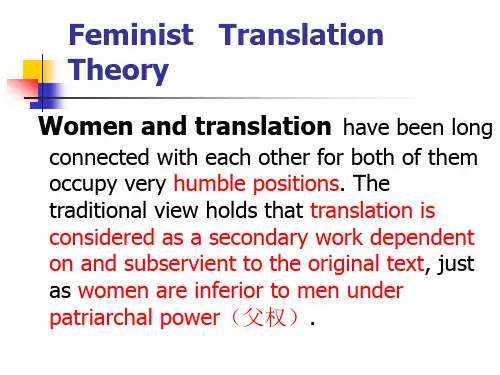

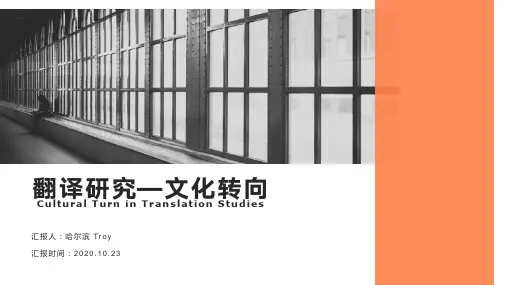

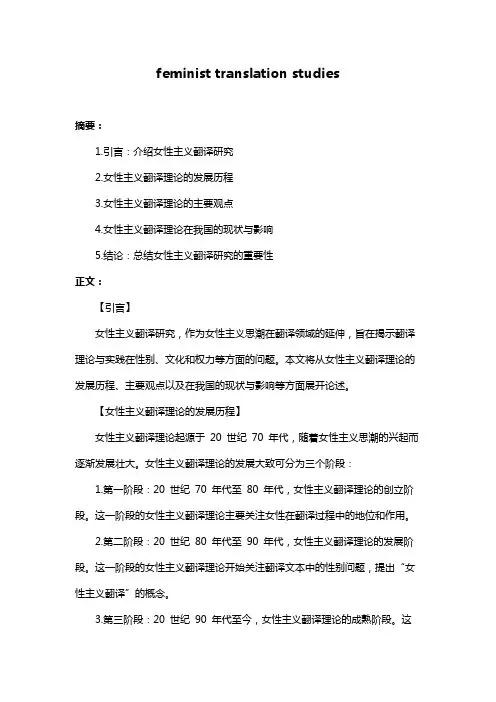
feminist translation studies摘要:1.引言:介绍女性主义翻译研究2.女性主义翻译理论的发展历程3.女性主义翻译理论的主要观点4.女性主义翻译理论在我国的现状与影响5.结论:总结女性主义翻译研究的重要性正文:【引言】女性主义翻译研究,作为女性主义思潮在翻译领域的延伸,旨在揭示翻译理论与实践在性别、文化和权力等方面的问题。
本文将从女性主义翻译理论的发展历程、主要观点以及在我国的现状与影响等方面展开论述。
【女性主义翻译理论的发展历程】女性主义翻译理论起源于20 世纪70 年代,随着女性主义思潮的兴起而逐渐发展壮大。
女性主义翻译理论的发展大致可分为三个阶段:1.第一阶段:20 世纪70 年代至80 年代,女性主义翻译理论的创立阶段。
这一阶段的女性主义翻译理论主要关注女性在翻译过程中的地位和作用。
2.第二阶段:20 世纪80 年代至90 年代,女性主义翻译理论的发展阶段。
这一阶段的女性主义翻译理论开始关注翻译文本中的性别问题,提出“女性主义翻译”的概念。
3.第三阶段:20 世纪90 年代至今,女性主义翻译理论的成熟阶段。
这一阶段的女性主义翻译理论逐渐形成了一套完整的理论体系,并开始关注女性在翻译实践中的挑战和机遇。
【女性主义翻译理论的主要观点】女性主义翻译理论的主要观点包括:1.性别意识:认为翻译过程中的性别问题应引起重视,翻译作品应关注女性在社会、文化、历史等方面的地位和作用。
2.文化差异:强调翻译应尊重原文的文化背景,充分考虑文化差异,避免将一种文化观念强加于另一种文化。
3.权力关系:认为翻译是一种权力关系,女性在翻译过程中可能面临各种权力压迫,因此需要关注女性在翻译实践中的地位和权力。
【女性主义翻译理论在我国的现状与影响】自20 世纪90 年代以来,女性主义翻译理论在我国逐渐受到关注。
目前,我国女性主义翻译研究已取得了一定的成果,并为我国的翻译实践和理论研究提供了新的视角和思路。
在女性的名义下“重写女性主义翻译理论对译者主体性研究的意义一、本文概述在全球化日益深入的今天,翻译作为一种跨语言、跨文化的交流活动,其重要性日益凸显。
然而,传统的翻译理论往往忽视了译者在翻译过程中的主体性,这在一定程度上限制了翻译研究的深度和广度。
特别是在女性主义翻译理论的视角下,译者的主体性更是被赋予了特殊的意义。
本文旨在探讨女性主义翻译理论对译者主体性研究的意义,从而揭示译者在翻译过程中的重要作用,并推动翻译研究的进一步发展。
本文首先将对女性主义翻译理论进行简要介绍,阐述其核心观点和理论基础。
随后,将深入探讨译者主体性的内涵及其在女性主义翻译理论中的体现。
在此基础上,本文将分析女性主义翻译理论对译者主体性研究的启示和影响,包括如何提升译者的地位、如何促进译者的自我认同以及如何发挥译者在翻译过程中的创造性等方面。
本文将总结女性主义翻译理论对译者主体性研究的贡献,并展望未来的研究方向。
通过本文的论述,我们期望能够深化对译者主体性的认识,推动翻译研究的多元化发展,并为女性主义翻译理论的研究提供新的视角和思路。
我们也期望通过这一研究,能够激发更多学者对译者主体性问题的关注和研究,共同推动翻译学科的繁荣和发展。
二、女性主义翻译理论的核心观点女性主义翻译理论的核心观点在于重新审视和改写传统翻译理论中的权力关系,强调译者在翻译过程中的主体性和创造性,以及在翻译实践中实现性别平等的重要性。
该理论认为,翻译不仅仅是语言的转换,更是一种文化的传递和权力的重构。
在传统的翻译理论中,译者常常被视为隐形的、被动的角色,而女性主义翻译理论则挑战了这种观念,认为译者应该成为翻译过程中的主体,发挥自己的创造性和主观能动性,对原文进行重写和再创造。
女性主义翻译理论的核心观点之一是“重写”(Rewriting)。
这一概念指的是译者在翻译过程中,不仅要考虑到语言的转换,还要考虑到文化、社会、历史等因素的影响,对原文进行重写和再创造。
女性主义翻译探究作者:刘艳侠来源:《读与写·下旬刊》2011年第11期摘要:女性主义翻译作为翻译领域的一个学派,为广大翻译研究者提供了一个女性所特有的研究视角。
当代西方女性主义者将视野投向文本,希望通过解构传统的男性中心主义话语,重建新型的男女平等关系。
本文从几位西方女性主义的代表人物及其著作来向读者展示女性主义翻译的思想内涵。
关键词:女性主义;男女平等;翻译理论Abstract:as a branch of translation theory, feminism translation has provided a feminist unique translation study perspective. Modern Western feminists cast their eyes into the text itself, hoping to reconstruct the equality of man and woman by deconstructing the traditional patriarchal discourse. This essay would represent the connotation of feminist translation through several representativeKey words:Feminist;gender equality;translation theory中图分类号:H059 文献标识码:A 文章编号:1672-1578(2011)11-0001-01从20世纪60年代西方第二次妇女运动浪潮起,女性主义作为一种犀利的社会文化批评话语崛起在西方世界,并逐渐从边缘走向了中心。
当代西方女性主义者将视野投向文本,希望通过解构传统的男性中心主义话语,重建新型的男女平等关系。
本文从几位西方女性主义的代表人物及其著作来向读者展示女性主义翻译的思想内涵。
以《夜莺与玫瑰》林译本和谈译本为例对比分析女性主义对翻译策略的影响摘要西方女性主义运动的蓬勃兴起,在翻译界一石激起千层浪,学者开始研究女性主义对翻译产生的影响。
本文从女性的语言特征,情感特征及译者主体性的强烈表达三方面对《夜莺与玫瑰》林译本和谈译本进行了对比,分析女性主义对翻译策略的影响。
关键词:夜莺与玫瑰; 林徽因; 谈瀛洲; 女性主义; 翻译实践AbstractThe booming of the western feminist movement has caused great response, scholars started to study how the feminist influences the translation. The paper analyses the effect that feminist has on the translation by comparing the edition of Lin’s and Tan’s of Nightingale and Rose on female’s language feature, emotion feature and translator’s subjectivity.Key words: Nightingale and Rose; Lin Huiyin; Tan Yingzhou; feminist; translation practice引言20世纪60年代,西方女性主义运动势头高涨,它主张女性在一切领域的权利,希望建立平等的两性生存空间。
在这种运动的影响下,20世纪90年代末,翻译界的研究者真正的注意到性别是翻译的重要因素,女性的译者主体地位在翻译研究领域才逐渐地被意识到。
并且,近几年来,中国翻译界对性别与翻译的研究不断升温,但主要是对西方女性翻译理论的重新阐述,较少有通过实践译本的对比来呈现性别差异对翻译实践的影响,本文将选取英国作家奥斯卡·王尔德的童话《夜莺与玫瑰》的两个中译本——林译本(林徽因)和谈译本(谈瀛洲)进行对比分析,进一步探讨在翻译实践中,女性主义对翻译策略的影响。
女性主义翻译研究对中国译界的影响朱运枚李志强(湖南科技职业学院湖南·长沙410004)中图分类号:H315.9文献标识码:A文章编号:1672-7894(2015)04-0200-03外语翻译基金项目:本论文为湖南省哲学社会科学基金项目课题“女性主义翻译观对传统译论的发展及叛逆的研究”,项目编号为12WHL21。
作者简介:朱运枚(1984—),女,湖南常德人,湖南科技职业学院教师,助教,湖南师范大学2007级研究生,研究方向为翻译理论与实践;李志强(1978—),男,湖南耒阳人,湖南科技职业学院教师,讲师,长沙理工大学外国语学院研究生,研究方向为翻译理论与实践。
摘要本文简介了女性主义及其翻译研究,概述了女性主义翻译研究在中国的发展现状,并通过翻译理论、翻译批评和翻译实践三个方面探讨了西方女性主义翻译研究对中国译界的影响,指出中国的女性主义翻译研究作为后起之军有其自身特点,亦待进一步发展和探索。
关键词女性主义翻译研究翻译理论翻译实践翻译批评The Impact of Feminist Translation Studies on Chinese Translation //Zhu Yunmei,Li ZhiqiangAbstract This paper introduces feminism and feminist transla-tion studies,and it gives an overall statement about the develop-ment of feminist translation studies in China.It analyzes the im-pact of western feminist translation studies on Chinese translation through three aspects:translation theory,translation criticism and translation practice.This paper points out that although feminist translation studies started late in China,it needs to be further de-veloped and explored with Chinese characteristics.Key words feminist translation studies;translation theory;trans-lation practice;translation criticism1引言女性主义翻译研究作为20世纪80年代翻译研究中的“文化转向”与女性主义运动相结合的产物,以其鲜明的女性主义话语及政治诉求,在众多新兴的翻译理论中异军突起。
The Influence of Feminism on TranslationAbstract: With development of translation study, translators and scholars started to pay attention to how culture factors influence upon translation work. Feminism is one of these new schools, proposed by a group of feminists that gender and sexual elements should be considered in translation. This paper aims to make a brief introduction of this famous school and tries to assess its influence in an objective and proper way.I.Background and Description of feminismTranslation studies, from traditional perspective, are mostly discussed in the interior of the text on such as lexicon level, grammar level, and discourse level. Until 1950s, scholars and translators gathered their focus on the “Cultural turn”: the term used in translation studies for the move towards the analysis of translation from a cultural studies angle. (Jeremy Munday, 2001). A lot of theories sprout up, of which most representative three are: rewriting, feminism and postcolonial translation theory. Feminism translation theories, with the most controversies among them, deserve a further discussion.In retrospection of the history of description of translation theories, we do find that most of them are related to gender, more specifically, to woman. Feminism translation theory is such a school focusing on this issue. To assess this series of theories critically, a comprehensive review and analysis is made about the influence of feminism on translation theories, translators, translation practices and translation works in this paper.II.Major points of view in this areaInitially, feminism is not a translational notion, but a sociological one. Feminism can be defined as a collection of movements and ideologies aimed at defining, establishing, and defending equal political, economic, and social rights for women (Merriam-Webster Dictionary). Simon de Beauvoir’s most famous assertion, from her The Second Sex, that “One is not born, but rather becomes, a woman” can be seen as the fundamental theory of feminism. Deducted from Simon’s words, translation is also gendered not by its nature, but the impacts and definitions given by human beings.So early in 17th century did people start to connect translation and gender. A famoustranslator John Florio (1603) said “Translations are defective and therefore all translations are reputed females.”And Sherry Simon, the most well-known pioneer of feminism translation school, in her Gender in Translation: Cultural Identity and the Politics of Translation (Simon, 1996), originally takes gender-studies factor into account in translation. She states that “Both women and the translation to the bottom of the social ladder” (Simon, 1996).In a word, translation work, compared with the source text, is always so-called second rate, between which the relationship is similar in gender—women are always inferior to men. That similarity brings possibility of the combination of the female and translation (Geng Qiang, 2004).III.The influence on translationAs a new-generated school, feminism translation theory did infuse new blood in people’s notion on translation in modern time. But it brought about a huge impact against traditional theories, with both praise and criticism. In this part, an elaborated analysis is made upon the influence on translation in three aspects.1.On translation theoryThe most shocking earthquake occurred in translation theory. When illustrating problems like what translation is and how translation works, translators and scholars tend to use a lot of descriptive words and even metaphors to make their viewpoints vivid and easy to be understood. Unfortunately, many of them are involved with terms about women, which in feminists’ eyes, suggesting obvious sexism and crude inequality. The most widely-known one is perhaps an assertion by Gilles Menage’s “Les belles infidelles”, which means “unfaithful beauty”, used to describe those translation works full of fine words but are not so close to the original one. Feminists also criticize these widely-used words in translation like fidelity, faithful and traitor for they indicate an unequal relationship between wife and husband.Feminists hence propose to avoid using such feminine-oriented terms, or at least discriminative words about women when describing translation theories. The influence of this campaign is indeed positive and significant. Their proposals help removing malefic factors of negative old-fashion from translation theory and generating a healthy academic atmosphere for translators. By adding gender factor into consideration, a hot topic then in politics, feminists strengthened a progressive trend associating translation and culture background rather thandiscussing translation solely limited translation itself. Translation, is not only a literal and inter-culture movement, also could be a political weapon. Just as a famous paragraph said by a committed feminist translator, Susanne de Lotbiniere-Harwood is “My translation practice is a political activity aimed at making language speak for women. So my signature on a translation means: this translation has used every translation strategy to make the feminine visible in language.” (Cited in Simon, 1996)2.On translation practiceIn practice, feminists attempt to omit suspiciously discriminative phenomenon in any language and highlight those feminine factors in the text by using some translation methods. Louis von Flotow (1991) summarized three main methods feminists often use in their translation practice: supplementing, prefacing and footnoting, hijacking. Supplementing is a common methods not merely used by feminists translators. But in their translation, the method mainly aims to supplement those meanings about gender which are absent in source text. An instance is in word HuMan, an extraordinarily capitalized M ironically demonstrates the sexism hided in the text. Prefacing is a much more ordinary method, including explaining writing background, demonstrating author’s intention, and introducing translation strategies, in order to underscore feminine factors in translation works. Hijacking means operating and appreciating the text and rewriting according to translators’intentions. Feminist translators often rewrite a text without gender significance into a new version to make the text expose feminine meanings. These main methods and others show a sense of independence and creativity of feminists.The influence of feminists’ creation in translation practices, positively, increases variety of translation strategies and techniques. But some of them, especially hijacking, did receive a severe controversy and even serious criticizing words. First of all, one result of hijacking is destruction of the source text by adding many translators’ subjective intentions. In the second place, hijacking strategy confusingly mixes translation and composition. Given too much transfiguration, it is hard for readers to justify a text of feminist translators on earth a translation work or an originally writing one.3.On translatorsWhen talking about translator, the influence of feminism is quite beneficial, for not only increasing status of female translators, improving their rewards, but recognizing their contribution and their creativity in translation.Both in translation and politics, feminists achieved their purpose of letting voices of females be heard. More attention started to be paid on female translators and their works, in which differences translation style from male translators to be recognized. In this aspect, feminism deserves its high reputation in history of translation.IV.Problem and CausesThroughout feminism translation theory, the problems and controversies it caused are almost as many as its contribution. The most famous one, as just mentioned, is feminist translators operate and appreciate source texts too much, for political accomplishment, which renders a harmful result that a yawning gap between their translated works and the original one. It is totally unbeneficial for translation practice.This result may attributes to their over-emphasis on “feminism” rather than “feminism and literacy”. After all, translation is a study related to language and literacy. Culture elements such as politics, should be considered, but too much participation will goes to reverse.V.Proposed solutionA possible solution for problems caused by feminism translation theory could be Androgyny, which refers to the combination of masculine and feminine characteristics (Oxford English Dictionary, 3rd ed.), is firstly used in ethics then in literacy and translation. Virginia Woolf, in her book A Room of One’s Own (1957), came up with this notion in literal composition for the first time. She says there is a sex ambiguity in one’s minds: one represents the masculine, the other the feminine and only when two sides stay in harmony, they could generate fantastic inspiration in a composer’s mind.Androgyny is perhaps a final target for all sexists. Indeed it is hard to be totally achieved in composition and translation, but some instances prove that it could be successfully accomplished in arts and literacy. One of four famous characters of Beijing Opera, Mei Lanfang is well-known for his marvelous and delicate performance as a woman, yet he is masculine performer. Most of great male writers also create many feminine characters in their fictions, poems or operas. Therefore, the same thing is likely to happen in translation as longas translators combine advantages of both sexes together when they try to adopt feminism translation strategy.VI.ConclusionIt is really a progress for translators and scholars to take external cultural elements such as politics, social ethics into account rather than only make a translation study in the Ivory Tower. Many new schools sprout up and majorities of new ideas grew up. It is necessary for translators to assess feminism translation strategy and its influence objectively and properly. What’s more, translators should have a capacity of avoiding too much external factors in translation practice. Best translation works, with no doubts, are those mostly close to the original text. Over emphasizing cultural factors may confuse and mislead translator, strain their focus from translation itself, which ultimately could be a catastrophe for translation. VII.References1 Munday J. Introducing translation studies: Theories and applications[M]. Taylor & Francis, 2008.2 耿强. 西方女性主义翻译理论述评[J]. 西南科技大学学报(哲学社会科学版), 2004, 3: 002.3 初雪燕. “双性同体”——女性主义翻译的健康发展之路[J]. 现代交际: 下半月, 2010 (007): 124-125.4 蒋骁华. 女性主义对翻译理论的影响[J]. 中国翻译, 2004, 25(4): 10-15.5 黄彩霞. 翻译的性别隐喻及女性主义翻译策略[J]. 中美英语教学, 2007, 4(11):66-68.6 张建萍, 赵宁. “翻译的性别” 和“性别中的翻译”——从女性主义翻译理论谈起[J].南京理工大学学报(社会科学版), 2009, 2: 019.。